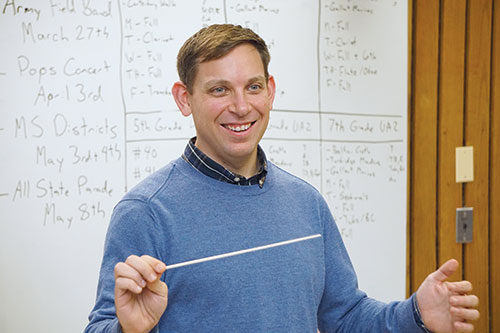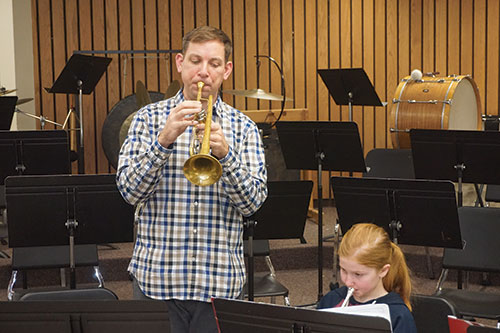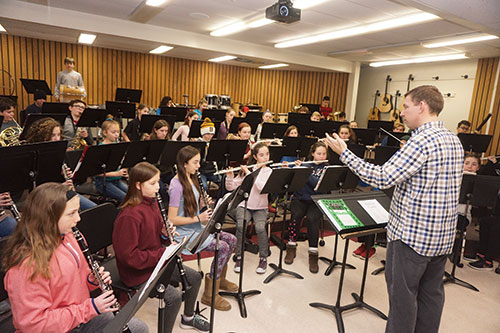Two clarinetists.
Two saxophonists.
One all-state oboist.
One All-Eastern tuba player.

This was the entire band program at Bellows Free Academy in Fairfax, Vermont when Ian Flint was hired. Band was not a scheduled class, but these six students took lessons and auditioned for all-state. Says Flint, “It had been six years since band had been part of the schedule, and I figured there might be some part of a music culture left, but it was gone. There was nothing, and although some people wanted it back, most didn’t even miss it.” In just three years, Flint has built up the program from those first six to 130 students in grades 5-12. Band is once again a part of the school schedule, and students at all levels are discovering the joy of instrumental music.
What led you to take this job?
I worked as a brass specialist for nine years at Dartmouth (Massachusetts) High School, a big program. It was my first full-time job after college, and it was a great experience. However, I also wanted to build my own program. I looked around New England and found this school in Fairfax, Vermont. The building opened in the 1900s, and the school had two band directors who taught there for nearly 80 years combined. For a long time this was a strong program in Vermont, even though the school was small. There were maybe 50 kids in the high school band program through the 1980s and 1990s before it diminished. A new principal joined the school the same year I was hired, and it was made clear the administrators and community wanted to fix the program.
What were the first days like?
For the first month of the year, I didn’t really teach. I just walked around the building trying to convince middle and high school students to play an instrument. Some of the earliest recruits had played in the past and agreed to come back. Others had been in band in lower grades at another school before coming here for high school. For the first performance I had no tenor voice in the band. We played flex band music, and I asked an area director to play trombone to cover the missing line. By spring I had recruited a handful of middle school students, including a sixth grade percussionist. That first year, everyone sixth grade and up played in the high school band. We rehearsed at 7:20 in the morning, an hour before school started. This isn’t an easy time to schedule in a rural school because some students live 30 minutes into the country, and they had to find a ride.
At the same time as I was bringing in older students, I also put a great deal of energy into recruiting the younger grades, with a goal of 50-70% participation in band. These students had never seen a band before, so part of the job was teaching them what one was. Some students asked about playing violin or guitar in band, and I had to explain that wasn’t something we could offer, given the time and resources we had.
At the same time as I was recruiting I had to rebuild the instrument inventory. There was a fairly decent inventory six or seven years before I got here, and about half of it had disappeared because instruments were given out but never collected. There was no accounting system. I had 10-15 workable instruments, including a 50-year-old tuba in rough shape. My initial focus was on trying to get the instruments back. I kept asking around the community whether anyone had an unreturned school instrument. People spread the word, and 15 instruments showed up by the end of the year. Many of these were from parents of students who graduated several years ago; they hadn’t realized their child had never returned an instrument.
I also pressed for donations. I asked teaching staff if they played in high school. A number hadn’t touched their instrument in a decade or longer, and we received 15-20 donations the first year. I made a deal with a local shop to trade multiple instruments that weren’t worth fixing for one that did work. Why repair a tenor sax if you can buy a good used one for $100 less than repairs would cost? The local repair shop is 90 minutes away, so we worked next on having spare instruments available. If a student’s instrument had to go out for repair, it might be gone for a week.
After two years, the school board saw what we were building and tripled our budget. At the same time, we received a grant from the endowment attached to our school, which we used to buy two tubas and two euphoniums. I mentioned my old tuba and pointed out that if we bought a new tuba, someday it too would be decades old and still in use. Over the course of a school instrument’s lifetime, 20 different students might use it. Instruments seem expensive, but pointing out how many students one instrument can help makes the price seem much smaller.
How did you get band scheduled into the school day?
People want to see results and then respond to that. I had to convince people to support the program before they got to see what would happen. In my second year, band still wasn’t part of the school day. We sat down with the whole staff, because adding a class like band affects almost everybody from fifth grade on up – three quarters of the teaching staff and all of the grade 5-12 students. We also had to figure out how band would interact with sports and other extracurricular activities. Fifth grade band was especially difficult to schedule; there had never been a designated time for a fifth grade full band before. There had been pull-out lessons, but the idea that a beginning band might play at a concert was new to the district.
I proposed the model from my high school, which had only 250 students. The last period of the day was prep for most of the teachers, with the exception of a physical education or shop class, but most of the student population was in one of the performing ensembles. If students are not in music or extracurricular activities, there is not much to do in a small town. Here there is one restaurant within 15 miles, and the gas station is also the grocery store. The school is the hub of activity for the town, and the parking lot is full most nights.

How is your program set up?
Fifth graders meet for lessons in groups of three to six for 45 minutes once a week, with full band on Fridays at the end of the school day. The sixth and seventh grade students are split into a woodwind class and a brass class for each grade, and the percussion will go with whichever one is smaller to balance class sizes. I prefer this approach, because students get more individual attention. Each of these four middle school classes has about 15 students, and even with these numbers, we still sometimes split into sectionals.
These students do not meet as a full band until two weeks before a concert; we schedule three to four rehearsals with everybody. The first full-band rehearsal focuses on students knowing how they fit into the ensemble. This day is full of fun surprises, such as clarinets and euphoniums learning they have the same part on a Karl King march, and students realize that these rehearsals are the payoff for the time spent working on technique and method book materials. They take it seriously. Rather than having the same thing every day, there is variety in the way things are structured, and I think this is an advantage.
In addition, all sixth and seventh graders get about five private lessons per year. I have specialists who come in one day a week and see each student in a rotation. This is essential for a number of reasons. Students need individual attention at this stage of development. Without this, it is difficult to isolate and fix any bad habits. I also view these lessons as essential for recruiting and retention. Some students might start to feel like they are getting behind their peers and want to quit. Having someone there to sit with them and tell them that their struggles are normal and okay because learning an instrument is difficult is important, and it keeps students motivated.
This is especially important given that I might only have five clarinets per grade. If two quit, I have lost 40% of my clarinets for that year, and over the years that can add up to a lack of depth in high school. With a high school clarinet section of 15, a student can be a role player, but if I only have four or five clarinets in high school and those few students are not dedicated to band to the exclusion of all else, that can affect the level of music you can program. I don’t want that to happen, nor do I want students to feel they have to give up other activities for band. Many of my students play basketball or are on the nordic ski team. Some play travel hockey, and they are gone every weekend during the season. Enforcing weekend practice isn’t an option for me. If you let students choose their activities, they will stay in band, but if you force a choice, students might not choose music.
I have a wide range of students in band. For some students I have to fill out a sheet every day to make sure they are doing the right thing in class. In a lot of programs those kids don’t stay in band, because if they can’t handle it they disappear. In my program that kid might be my only seventh-grade percussionist, and I have to do everything I can to keep that kid, because he is a good musician, even if he isn’t a model student.
High school band includes eighth through twelfth grade. Right now there are 40 students, almost all of whom I recruited. Most of the students are no more than third- or fourth-year players – it’s a bit like a typical eighth grade band. I have a fair number of juniors who are second-year players. I recruited their friends in eighth grade, and when they were sophomores, they decided to join band, too. For a while, I had this odd scenario where students just started showing up.
I insist upon a high-school curriculum and that the music we play is grade 3 and 4 works, although we play easier music, too. The focus is not about how difficult of a piece I can program with this group, but rather about trying to meet the national standards and give them the experience they should have. This takes a lot of work, but it is amazing how quickly high school students pick things up. I have a senior trombone player who joined band for the first time this year. In five months he went from having never played an instrument before to making the district band.
How do you get inexperienced older students up to speed?
Partner beginning high school students with a more experienced player. The high school band rehearses five days a week, but we devote two of those days to sectionals, during which I will work with a section while the rest of the students find a place to practice and teach each other. They start with our beginning method book – the same one we use in fifth grade – but work through it at an accelerated pace. A high school student’s first lesson might be all the way through a Bb major scale.
YouTube has many videos of band directors teaching first lessons. I give older beginners a link and tell them to watch the same video once a week for the first few weeks. The material is basic but provides a great way to review good habits. There isn’t much time in the day for me to offer direct one-on-one instruction with high school students, but at that age, it is more important that they know how to teach themselves. A fifth grader will have a difficult time taking in information, analyzing it, and forming a plan, but a high school student can experiment and figure things out.

How are you raising the program’s profile in the school and community?
If everyone is a participant in the music program, then the program is valued. We just started a booster program this year. They will raise thousands of dollars for us, but to me the support and advocacy the group provides is more important. These volunteers make sure that the parents and community know what is happening in the music program.
We invite teachers to concerts and reserve seats for teachers who say they are coming. We thank and acknowledge them at performances, too. They feel like a part of the program, and if music students have to miss a class for a dress rehearsal, I don’t have anyone pushing back against that. In a school this size, it would only take two or three unsupportive teachers for me to lose a quarter of my students from a dress rehearsal.
I talk at faculty meetings, but never about how great the kids were in the performance. We discuss about the school culture and the positive aspects – the traits that we’re trying to instill. There has been a lot of buy in because of that. News bulletins to parents are the same. These never have anything to do with playing hard music and going to contests and getting a superior. We go to contests and aim for superior ratings, but that is merely a result of the culture of the program. If we do everything correctly, those things will just happen. We try to be the best version of ourselves.
The school building houses everything from Pre-K through high school, so having the high school band and choir perform for the elementary students is just a three-minute walk down two hallways. Occasionally, on days when it is too cold for students to have outdoor recess, we would give a short concert for the elementary students. Just two songs, one of which is a flex band version of Frozen or something similar that students can sing along with, is enough to create excitement. The elementary has a morning meeting every Friday, and we might put on a pop-up concert for them. For Music in the Schools Month we perform each week. The high school kids love putting one these performances.
We invited the local reserve band for a clinic with our band, and then we gave a 45-minute combined concert for the elementary kids, complete with a sing-along. They loved it, and I got to show students a 60-piece band right before I start talking to fourth graders about joining band next fall. They’ve just seen a performance, and they understand the opportunities. I also make sure to have a student soloist – usually on an instrument I would like to recruit more of – featured in March. Last year I featured my all-state oboist, and four fifth graders chose the oboe after hearing her play.
How is the community reacting to the rebuilding of the music program?
Right now, this is the biggest challenge for both the choral director and me. My first beginning band class is only in seventh grade right now. The middle school ensembles sound like an appropriate middle school band and choir. Then the high school groups come on, and people expect it to be phenomenal, and we have to point out that we aren’t even halfway there yet. We are right where I thought we would be four years in, but I have been thinking about eight years in, when almost all the students will be beginners I started. We are a small school, but I think we can be a model program for the state.
What advice would you offer a teacher in a similar situation?
Do not try to do what you think is right. Instead, do what is right for the community. Many people take a first job in small schools like this. They are out of college and have all these grand plans, but such plans are sometimes infeasible. I grew up with competitive marching band, but running such a thing in Vermont is not an option. There is no band circuit here; the closest show is more than three hours away. We started a marching band at the beginning of this school year, bought used uniforms from a high school in Ohio, and are marching in our first parade in April. Marching band here is about community engagement.
Analyze what is possible, and work toward that; this is the path to success and support. I think a lot of programs are cut because they do not cater to what the community needs. My directors always chose what was right for that community. I am trying to do the same thing here.
Working in a school like this is just as rewarding as working for the National Champion High School marching band or a similar program. We are both teaching students to be the best musicians they can be. A lot of people come to small-school jobs thinking they will move on in a few years. Honestly, if this had been my first job after college, I might have thought the same. I don’t see that way now. This was definitely a step forward in my career. I walk in here every day and think, “I’m doing what works for me, the community, and the students.” I am proud of what is happening here.





